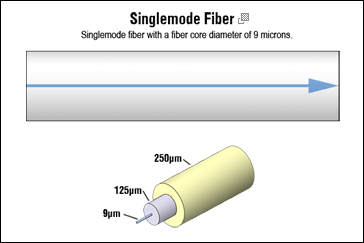- Related articles
- What Is GYTZA Fiber Optic Cable?
- Buy Cisco GLC-SX-MM SFP For Fiber Optic Networks
- All Cisco XFP-10G-MM-SR's information (List price, Specs, Datasheet PDF, Compatibility mat
- What Is Internal Ethernet Card?
- Optical Transceivers for Cisco WS-CBS3125G-S Switch
- What is Optical Ethernet?
- Applicable to 100BASE-BX Standard optical transceiver models
- The difference between QSFP+ and X2
- What is a transceiver used for?
- Optical Transceivers for Cisco WS-C4500X-F-32SFP+ Switch

Definition of Single Mode Fiber Optic Cable
Single Mode Fiber Optic Cable is the type of fiber optic cable that has been designed to carry or transmit a single mode or ray of light at a time. Single Mode Fiber Optic Cable in most suitable or highly used in the transmission of signals over a long distance and therefore, a company should install another type of cable that is suitable to carry suitable over short distances.

Characteristics of Single Mode Fiber Optic Cable
Like multi-mode optical fibers, Single Mode Fiber Optic Cable do exhibit modal dispersion resulting from multiple spatial modes but with narrower modal dispersion.[citation needed] Single mode fibers are therefore better at retaining the fidelity of each light pulse over longer distances than multi-mode fibers. For these reasons, single-mode fibers can have a higher bandwidth than multi-mode fibers. Equipment for single mode fiber is more expensive than equipment for multi-mode optical fiber, but the single mode fiber itself is usually cheaper in bulk.
A typical single mode optical fiber has a core diameter between 8 and 10.5 µm[6] and a cladding diameter of 125 µm. There are a number of special types of single-mode optical fiber which have been chemically or physically altered to give special properties, such as dispersion-shifted fiber and nonzero dispersion-shifted fiber. Data rates are limited by polarization mode dispersion and chromatic dispersion. As of 2005, data rates of up to 10 gigabits per second were possible at distances of over 80 km (50 mi) with commercially available transceivers (Xenpak). By using optical amplifiers and dispersion-compensating devices, state-of-the-art DWDM optical systems can span thousands of kilometers at 10 Gbit/s and several hundred kilometers at 40 Gbit/s.
The lowest-order bounds mode is ascertained for the wavelength of interest by solving Maxwell's equations for the boundary conditions imposed by the fiber, which is determined by the core diameter and the refractive indices of the core and cladding. The solution of Maxwell's equations for the lowest order bound mode will permit a pair of orthogonally polarized fields in the fiber, and this is the usual case in a communication fiber.
Singlemode cables have a smaller glass core than multimode cables and because there is less dispersion of the light signal in the fiber, they can transmit the signal a greater distance. To get this more precise light signal, the transmitters and receivers used at each end of the fiber are typically more expensive than those for multimode fiber. The signals used in multimode fiber are usually 1310nm and 1550nm wavelengths. In Wave Division Multiplexing (WDM), additional wavelengths may be used.
Conclusion
Single Mode Fiber Optic Cable has made the work of transmitting signals easily. Today, the corporate world is doing very well recording sound returns due to the wide use of Single Mode Fiber Optic Cable. Consequently, the economy of many countries is growing favorably with a good percentage of its population working to install the Single Mode Fiber Optic Cables hence bring them income.





















































